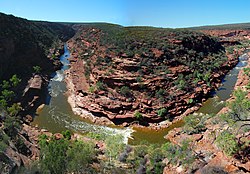
The Z Bend lookout is a popular tourist lookout on the Murchison River Gorge in Western Australia. It is located at 27°39′19″S114°27′19″E / 27.65528°S 114.45528°E , [1] [2] about 30 kilometres (19 mi) east of Kalbarri, in the Kalbarri National Park. One of four lookouts in the national park, it is situated on a sharp bend in the gorge. The view includes an excellent section through the Tumblagooda Sandstone, a geological sequence of fluvial and coastal deposits over one kilometre (0.62 mi) deep. [3]